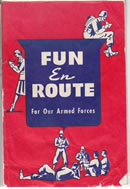Edward J. Thomas - Bronze Battle Star
A guy I worked for, while a student at Michigan State University said, the only ones that were sent to the Aleutian Islands were the anti-social types. Well, my Uncle Eddie was the most social of people when out in the public. So I will put that old wive's tale to rest.
I have been telling the life story of soldiers, including my uncle for well over seven years, with my six year old website www.lettersfromasoldier.com site. So I knew my uncle was a great secretary, a four year college graduate and working at the prestigious Ford Motor Company during the 1940s when this 33 year old man was drafted in the United States Army in February 1943.
He would train in rifleman's shooting and boot camp at Fort McClellan, Alabama and then processed and sent to Alaska. As I have written, with the help of his letters, most typewritten, he was a great typist and one of the fastest shorthand clerks the Army had.
So I often wondered why he started his secretarial job up in the frigid lands of the Aleutians. Now I know that he didn't start as an office worker, but rather entered the scene in Alaska at the time of two fierce battles fought against Japan were going to get the last foreign country to invade America off our soil! Here is what Eddie tells his cousin Stanley, a ship welder in California...
From my previous letter you knew I was in 138th Headquarters Company and you questioned some sources as to what work was handled by men here. The source of your inquiry was pretty accurate since you told me that Hq. Co. covers anything such as ditch digging, driving trucks or office work. Your assumption I was doing office work was wrong. That time I was taking part in some intensive training which was a review of a little of the basic training I had back in the states. Before this training was over and before I could get settled down to the pleasant and stimulating work of ditch digging I was transferred to Service Co. of the 153rd Infantry which is my present address, as this typewritten letter indicates. I am working in an office. My life is now a great deal less strenuous and rugged. Since I am mostly indoors and can thumb my nose at the weather (I think I better knock on when I say that - - so here goes ---
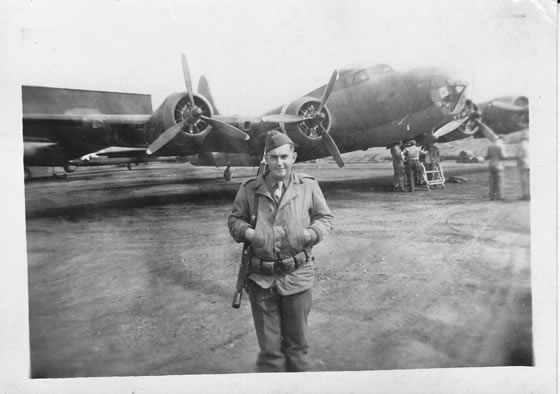

I believe my uncle would have stayed on Adak Island while he was in this brief 138th Infantry perhaps on training missions to Kiska, in what was called 'Operation Cottage'. (Previously I stated that my uncle was on Umnak Island)
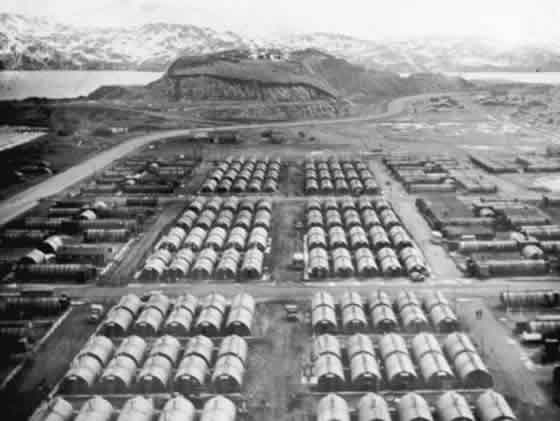
The depression of the 1930s had a strong effect in Japan, as it's small size partly magnified it's economic problems, employment of it's citizens. Militarism reigned and Japan became an aggressor with the hundreds of islands in the Pacific being it's chess squares. So the Japanese wanted domination of the Pacific. This they undertook by securing as many islands as the eye could see on the world globe. This would include the Midway Islands which had a fierce battle with Allied Troops, but they also took over a couple of islands on two western islands in the Aleutians, Attu & Kiska.
 The Aleutians stretch over 1000 miles from the Alaskan Peninsula forming a volcanic derived natural bridge between North American and Asia. This makes this American territory during the 1940s a strategic area. Japanese commander Admiral Isoroku Yamamoto envisioned Midway Island and islands of the Western Aleutians to be two sites to setup a defense to hold their stronghold in the North Pacific.
The Aleutians stretch over 1000 miles from the Alaskan Peninsula forming a volcanic derived natural bridge between North American and Asia. This makes this American territory during the 1940s a strategic area. Japanese commander Admiral Isoroku Yamamoto envisioned Midway Island and islands of the Western Aleutians to be two sites to setup a defense to hold their stronghold in the North Pacific.
The United States had 45,000 troops in Alaska in June 1942 at Fort Randall, Dutch Harbor and Fort Glenn on Umnak Island of the Aleutians.
Wed. June 3, 1942 was the first Japanese attack on Dutch Harbor lasted two days, and brought considerable damage with fire and smoke from several building that were hit. The Japanese would be forced to send reinforcements to aid in the Battle at Midway. A couple of days later, Japan invaded and occupied the two, more western Aleutian islands of Attu and Kiska.
A few days later, the Japanese would invade Attu & Kiska, very remotely inhabited. They would hold these islands for almost a year. This would be the first time since the War of 1812 that any foreign country would have seized and claimed American soil. Navy planes, B24 for instance would attack Kiska later in June 1942. But the Japanese dug in on Attu and Kiska.
In 1939, FDR sent a new Governor, Ernest Henry Gruening to lead the Alaska Territory in 1939. He would serve in that role until 1953. He would ally with Major (later Lt. General) Simon B. Buckner, Jr. Rear Admiral Robert A. Theobald would be in charge of naval operations and air forces, while Major (later Lt. General Buckner would lead the ground forces in the Aleutians. Among the officers in charge, they apparently were decent with the Alaskan natives, Aleuts and encouraged them to vote, let them know they were Americans, and gave them responsibilities to

(Courtesy U.S. Army Veterinary Corps Historical Preservation Group - Greg Krenzelok)
Umnak Island, had an airport built in 1942, but had to use corrugated steel planks, called Marsden matting with it's interlocking pieces. Paving was impossible on Umnak Island due to its soggy terrain. The new airport would operate 24/7 around the year.
To fly missions from Umnak to the Attu & Kiska Islands took 1200 miles round trip. Adak Island which was much closer, about 200 miles away, was not suitable for an airfield, unless the Army Corp of Engineers could drain the lagoons first. So they devised an ingenious levee system with gates that could be raised and lowered. The mechanism of which the gates were raised when tides went out and then lowered before the tides could change. So they built an airport there in just two weeks.
With our cold weather northern country of Canada, we patrolled the oceans around Kiska & Attu to deny Japan supplies.
May 1943 would be the bloodiest battle, with 11,000 Allied soldiers attacking some 2,600 Japanese troops on Attu Island. After 9 days of fighting, the Americans were just too numerous, Thur. May 20 according to Japanese officers, said his men were determined to die in battle. After 20 days, the Americans would surround them on dry land. May 29, the Japanese officer was all but defeated. He ordered their code books and radios destroyed. All but 29 of the 2600 Japanese troops died. 549 Americans died with 1148 Americans were wounded.
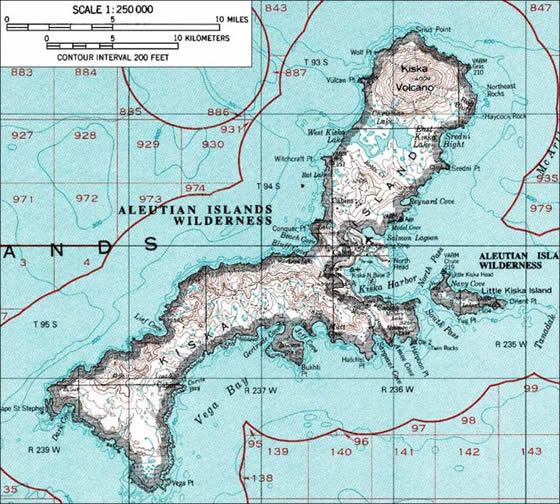 Kiska was by itself. Americans were near victory in the Aleutians. 5400 Japanese on Kiska Island were preparing for death now. It was a sacred decision for them to die rather than be captured. But by mid-June the Japanese were planning their escape.
Kiska was by itself. Americans were near victory in the Aleutians. 5400 Japanese on Kiska Island were preparing for death now. It was a sacred decision for them to die rather than be captured. But by mid-June the Japanese were planning their escape.
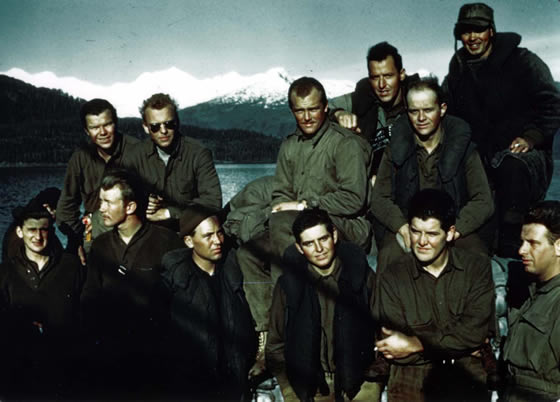
(Courtesy Christine. Her dad is top second from right. He has his hand on the shoulder of Steve Knowlton. Many of these men came back from the war and helped started Colorado's ski industry.)
Mon. July 26, part of the American fleet saw blips of what could be Japanese leaving. Much ammunition was fired. Experts attributed the radar blips to be atmospheric and possibly errors in the otherwise new technology of Radar. This would be referred to as the 'Battle of the Pips'. That Radar was new was used as one of the causes. Another later would be said to be flocks of birds that congregate. Some have said that Japanese I-Subs were in the area. Whatever happened during July 1943, the Japanese soldiers on Kiska managed to escape and headed west toward Japan.
Thur July 29, the desperate Japanese heading to Kiska, fled Kiska.
For three weeks the Americans bombed Kiska, unaware that the Japanese had probably already evacuated. 21 men killed 121 wounded by the Allies going into Kiska, both Americans & Canadians. They saw the evidence and leftover food left by the retreating Japanese.
Unbearable Forgotten War Aleuts return to the Aleutians every year to honor those that fell from both sides.
Governor, Ernest Henry Gruening became a United States Senator from Alaska from 1959 until 1969 after Alaska gained Statehood in 1959. He supported human rights and fought against the Vietnam War.

